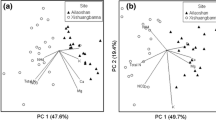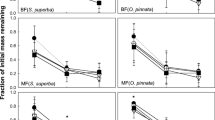Abstract
The spatial variation (within a 100 × 100 m plot) in the pollution of forest litter with heavy metals (Cu, Cd, Pb, and Zn), its acidity, and phytotoxicity (measured by the results of the root test using seedlings from a genetically homogeneous sample of common dandelion (Taraxacum officinale s.l.) have been estimated. Forest litter has been sampled in three zones differing in the toxic impact of long-term polymetal pollution by emissions from a copper-smelting plant emissions in the Middle Urals. The phytotoxicity variation is maximum in a moderately polluted plot, where both very high and very low pollution levels were observed, which determines a substantially nonlinear dose–effect relationship. The litter phytotoxicity is mainly accounted for by exchangeable forms of metals. Biological testing of samples from the most polluted plot has demonstrated marked antagonism between heavy metals and acidity.
Similar content being viewed by others
References
Alva, A.K., Huang, B., and Paramasivam, S., Soil pH Affects Copper Fractionation and Phytotoxicity, Soil Sci. Soc. Am. J., 2000, vol. 64, pp. 955–962.
Bezel', V.S., Pozolotina, V.N., Bel'skii, E.A., and Zhuikova, T.V., Variation in Population Parameters: Adaptation to Toxic Environmental Factors, Ekologiya, 2001, vol. 32, no. 6, pp. 441–447.
Brun, L.A., Maillet, J., Richarte, J., et al., Relationships between Extractable Copper, Soil Properties, and Copper Uptake by Wild Plants in Vineyard Soils, Environ. Pollut., 1998, vol. 102, pp. 151–161.
Brun, L.A., Maillet, J., Hinsinger, P., and Pepin, M., Evaluation of Copper Availability to Plants in Copper-Contaminated Vineyard Soils, Environ. Pollut., 2001, vol. 111, pp. 293–302.
Ermakova, I.M., Dandelion: Nomenclature and Taxonomic Position, in Biologicheskaya flora Moskovskoi oblasti (Biological Flora of Moscow Oblast), Moscow, 1990, vol. 8, pp. 210–269.
Gray, C.W., McLaren, R.G., Roberts, A.H.C., and Condron, L.M., Effect of Soil pH on Cadmium Phytoavailability in Some New Zealand Soils, New Zealand J. Crop Horticult. Sci., 1999, vol. 27, pp. 169–179.
Kapustka, L.A., Lipton, J., Galbraith, H., Cacela, D., and LeJeune, K., Metals and Arsenic Impacts to Soils, Vegetation Communities, and Wildlife Habitat in Southwest Montana Uplands Contaminated by Smelter Emissions: 2. Laboratory Phytotoxicity Studies, Environ. Toxicol. Chem., 1995, vol. 14, pp. 1905–1912.
Ladonin, D.V., Heavy Metal Compounds in Soils: Problems and Methods of Study, Pochvovedenie, 2002, no. 6, pp. 682–692.
Poddubnaya-Arnol'di, V.A., Tsitoembriologiya pokrytosemennykh rastenii (Cytoembryology of Angiospermous Plants), Moscow: Nauka, 1976.
Pozolotina, V.N., Zhuikova, T.V., and Bezel', V.S., Mechanisms of Adaptation to Technogenic Stress in Plant Cenopopulations (Taraxacum officinale s.l.), Dokl. Ross. Akad. Nauk, 2000, vol. 371, no. 4, pp. 565–568.
Rasteniya v ekstremal'nykh usloviyakh mineral'nogo pitaniya: ekologo-fiziologicheskie issledovaniya (Plants under Extreme Conditions of Mineral Nutrition: Ecophysiological Studies), Shkol'nik, M.Ya. and Alekseeva-Popova, N.V., Eds., Leningrad: Nauka, 1983.
Redente, E.F., Zadeh, H., and Paschke, M.W., Phytoxicity of Smelter-Impacted Soils in Southwest Montana, USA, Environ. Toxicol. Chem., 1996, vol. 21, pp. 269–274.
Salam, A.K. and Helmke, P.A., The pH Dependence of Free Ionic Activities and Total Dissolved Concentrations of Copper and Cadmium in Soil Solution, Geoderma, 1998, vol. 83, pp. 281–291.
Tyler, G. and Olsson, T., Concentrations of 60 Elements in the Soil Solution as Related to the Soil Acidity, Eur. J. Soil Sci., 2001a, vol. 52, pp. 151–165.
Tyler, G. and Olsson, T., Plant Uptake of Major and Minor Mineral Elements as Influenced by Soil Acidity and Liming, Plant Soil, 2001b, vol. 230, pp. 307–321.
Vorobeichik, E.L., The pH of Soil Litter and Its Relationship with the Soil Biota under Toxic Pollution, Lesovedenie, 2003, no. 2, pp. 32–42.
Vorobeichik, E.L., Sadykov, O.F., and Farafontov, M.G., Ekologicheskoe normirovanie tekhnogennykh zagryaznenii nazemnykh ekosistem (Setting Ecological Safety Norms for Technogenic Pollution of Terrestrial Ecosystems), Yekaterinburg: Nauka, 1994.
Zhivotovsky, L.A., Populyatsionnaya biometriya (Population Biometrics), Moscow: Nauka, 1991.
Author information
Authors and Affiliations
Rights and permissions
About this article
Cite this article
Vorobeichik, E.L., Pozolotina, V.N. Microscale Spatial Variation in Forest Litter Phytotoxicity. Russian Journal of Ecology 34, 381–388 (2003). https://doi.org/10.1023/A:1027308400182
Issue Date:
DOI: https://doi.org/10.1023/A:1027308400182




